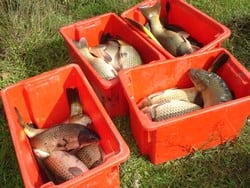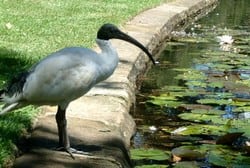The term ‘pest’ is used to describe both introduced species and non-endemic native species that contribute to the degradation of the local environment.
Pest species often impact on native flora and fauna by competing for food and shelter with, and predating upon, native species. Pest species can also contribute to environmental degradation, contribute to the spread of disease and give rise to safety issues through their impacts on the environment.
Centennial Parklands manages pest species to minimise their impact on the environmental, cultural and heritage values of the Parklands.
European carp
 European carp (Cyprinus carpio) is a freshwater fish native to Asia, originally introduced to NSW and Victoria as an ornamental and aquaculture fish. Carp occur in most freshwater systems in eastern Australia, including Centennial Park. Carp are now considered one of the most serious freshwater pest species in Australia.
European carp (Cyprinus carpio) is a freshwater fish native to Asia, originally introduced to NSW and Victoria as an ornamental and aquaculture fish. Carp occur in most freshwater systems in eastern Australia, including Centennial Park. Carp are now considered one of the most serious freshwater pest species in Australia.
Carp degrade the water quality of the ponds and limit the opportunity for native fish populations to become established. They are prolific breeders and reduce the survival chances for native fish.
Their benthic feeding processes (feeding at the bottom of the pond) whereby they suck in substrate and water in search for aquatic organisms decreases water quality by increasing turbidity and contributing to erosion of the banks of the ponds.
In 1996 the Water Quality Management Plan identified that carp were a major contributor to poor water quality. Over the years, various carp control methods have been trialled including electro-fishing, netting and line fishing. Although several tonnes of carp have been removed, these programs have not eradicated the carp population which remain an ongoing problem.
Australian bass (Macquaria novemaculeata) - a native fish species - has been introduced into the pond ecosystem.
Red-eared Slider Turtle
The red-eared slider turtle is an invasive animal that originates from the USA but has been intensively bred, transported and traded internationally. Due to their escape and intentional release, this species has established feral populations in many parts of the world including areas of NSW. Because this species competes with our native fauna and can carry diseases of concern, NSW Department of Primary Industries (DPI), in collaboration with Greater Sydney Local Land Services and Centennial Parklands, are currently conducting research to develop a management program for red-eared slider turtles.
European fox
Deliberately introduced into Australia in the 1860s, the European fox (Vulpes vulpes) is a widespread urban pest. It is one of the largest terrestrial predators in Australia and is a predominantly carnivorous, opportunistic feeder. Its diet includes small mammals and wild fruits though it will forage amongst human garbage.
Within the Parklands, the fox threatens native species by preying on the brushtail possums and turtle eggs. It can contribute to resource degradation by digging dens in which it lives.
Centennial Parklands does not use fox baits. We have a fox control program led by a licenced feral pest management specialist that includes den fumigation and soft-jaw leg hold traps.
We do not undertake any fox control work where members of the public or dogs could be affected, the program is targeted to fenced-off bushland remnant areas and depot. There is no dog access to these areas. The Parklands ensures animal ethics, environmental and safety considerations are part of the fox control work.
The last fox control work was undertaken in February 2021.
Pigeon
Pigeons (Columba livia) are recognised as a pest species in the Parklands. Sites, such as the Equestrian Centre, where there is ample food combined with suitable nesting and breeding sites enable the pigeon population to reach numbers at which they can negatively impact on infrastructure, animals and humans.
Pigeons can spread bacterial and fungal diseases to humans, mites and fleas to humans and horses and their excrement can accelerate the deterioration and corrosion of buildings and infrastructure.
They are territorial and can successfully compete for nesting sites and food, excluding native birds from the same resources.
A range of techniques including bird-spikes are used to manage pigeon populations.
Rabbits
The European rabbit (Oryctolagus cuniculus) is widespread through urban parks and much of rural Australia. Within Centennial Parklands rabbits historically contributed to localised erosion and bank instability through digging and burrowing, and their feeding degraded vegetation and ground cover and also posed a threat to formal floral displays.
Rabbits also support fox populations by providing an additional food source and habitat. Rabbits reach sexual maturity at only 3 months of age and a female can produce up to eight litters a year, each with four to five kittens. With control programs it is essential to ensure kittens still living in the warrens have been destroyed as well as the adults visible outside.
Rabbits have currently been eradicated from the Parklands using a combination of tactics including fumigation of warrens, poison baits and shooting. Calici virus or Rabbit Hemorrhagic Disease, released twice in Australia, has been of limited success as a biological control.
Visitors are often caught dumping unwanted pet rabbits in Centennial Park.
The dumping of animals is not permitted and can incur a fine. Pet rabbits are usually not able to survive on their own, and can easily fall prey to predators such as foxes or cats, adding to the problem of pest animals in Centennial Parklands.
Ibis
 The sacred ibis (Threskiornis molucca) or Australian white ibis is easily identified by its bald head, long curved black beak and white plumage. It is often seen congregating in large numbers on the islands in Centennial Park or picking around bins and barbecue areas looking for food scraps.
The sacred ibis (Threskiornis molucca) or Australian white ibis is easily identified by its bald head, long curved black beak and white plumage. It is often seen congregating in large numbers on the islands in Centennial Park or picking around bins and barbecue areas looking for food scraps.
Australian White Ibis is an important species of inland wetlands and waterways, and has been disrupted in its natural distribution by drought and habitat destruction. As a result large populations have moved to the eastern cities where the birds find ample food supplies provided by humans in rubbish bins and waste dumps.
As their population size increases Ibis can cause a number of problems in the Parklands. Their nesting habit which uses a platform of sticks can damage native vegetation and their dense concentration at nesting sites causes habitat destruction.
As scavengers they spread rubbish and are a frequent nuisance to visitors, especially picnickers. The high phosphate content in their excreta can also negatively affect the water quality of the ponds.
To manage the impacts of ibis, the vegetation of known nesting sites has been modified to discourage ibis from breeding.
Domestic ducks and geese
Many park visitors do not realise that the domestic mallard ducks, white ducks, and Toulouse and Emden geese that inhabit the ponds are not native species.
Visitors are not permitted to release domestic ducks or geese into Centennial Park as they compete for resources with native birds. Pet domestic ducks and geese are unable to fend for themselves after being in captivity, and can easily fall prey to foxes.
Contact the RSPCA or WIRES for advice on the relocation of unwanted domestic ducks and geese.